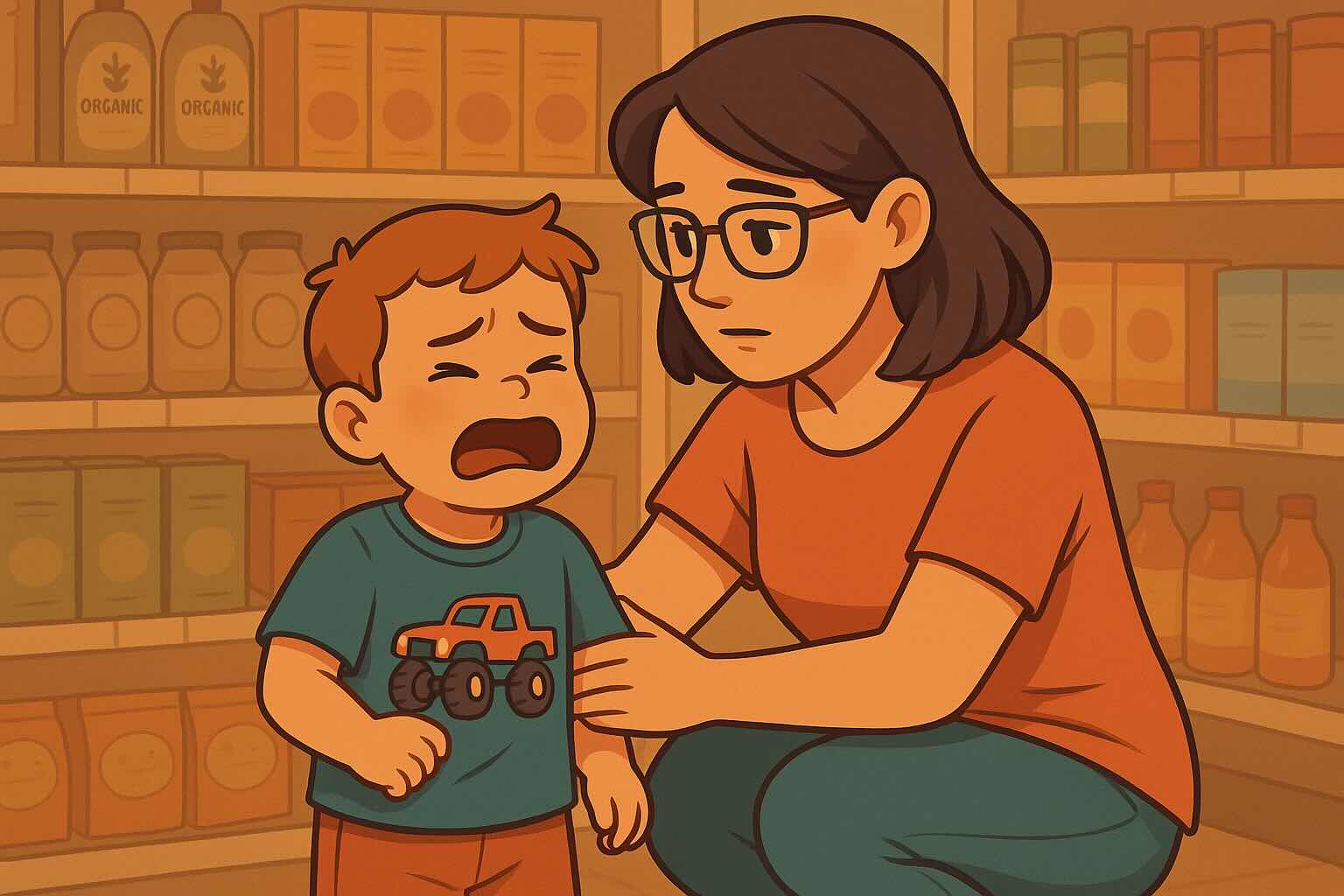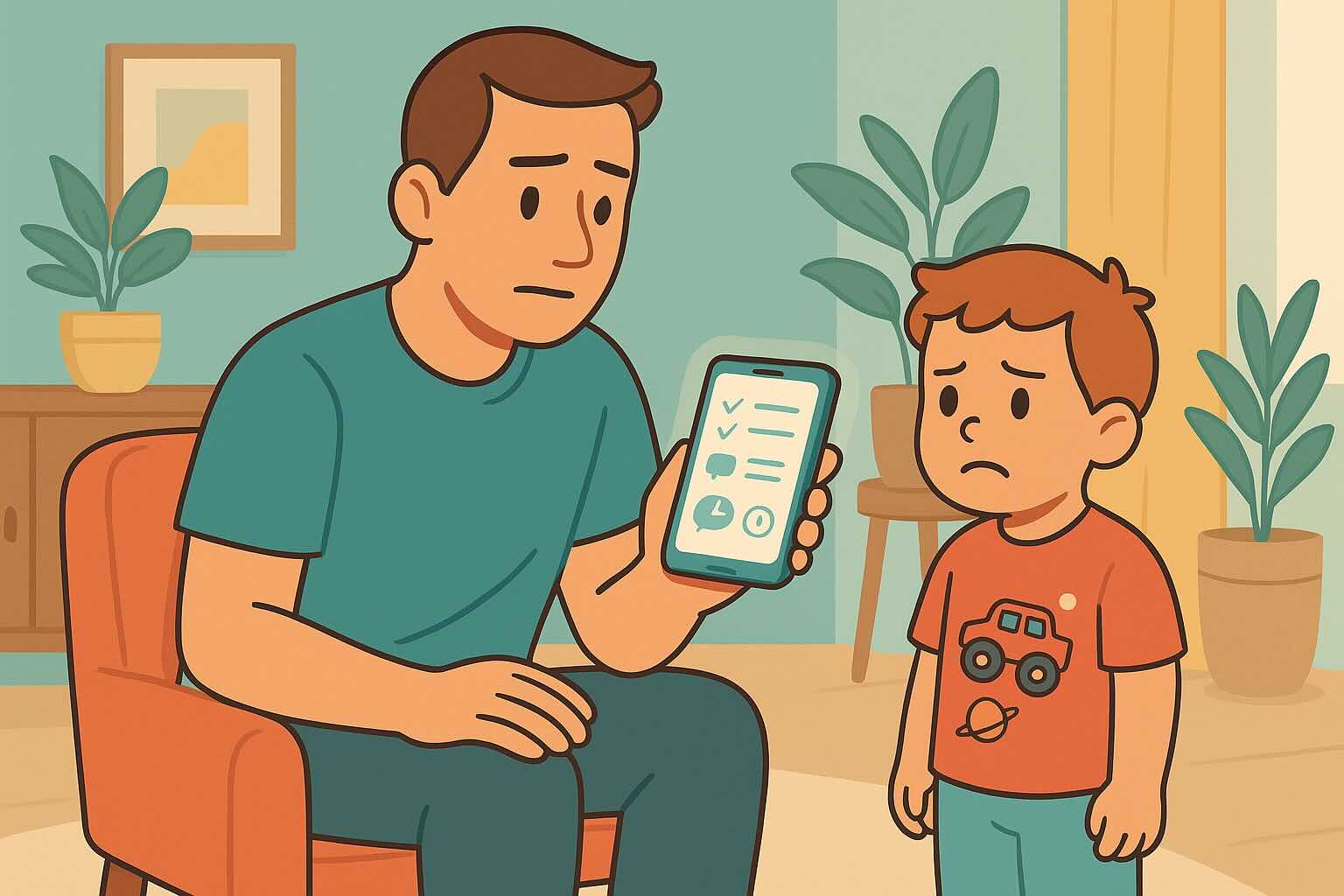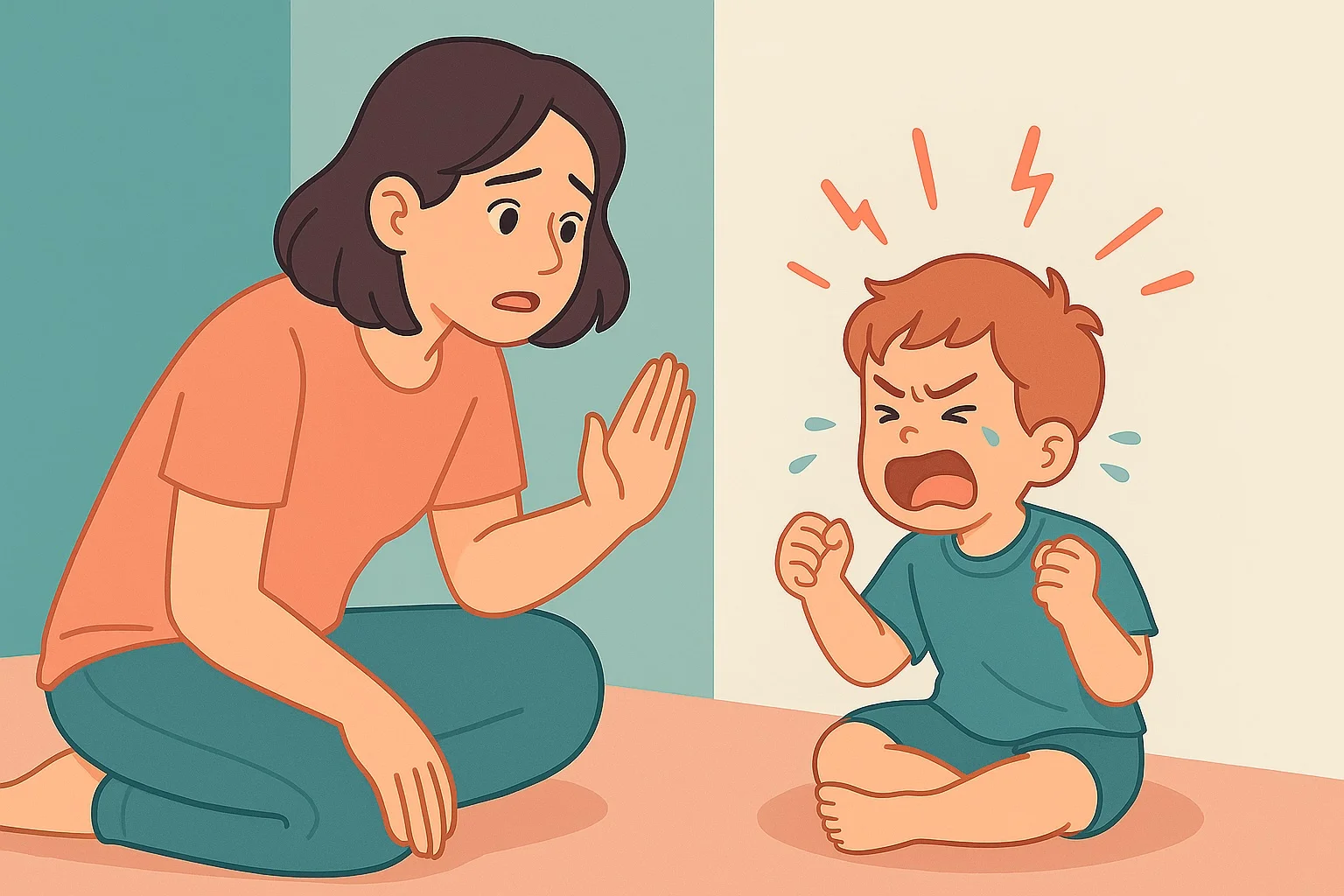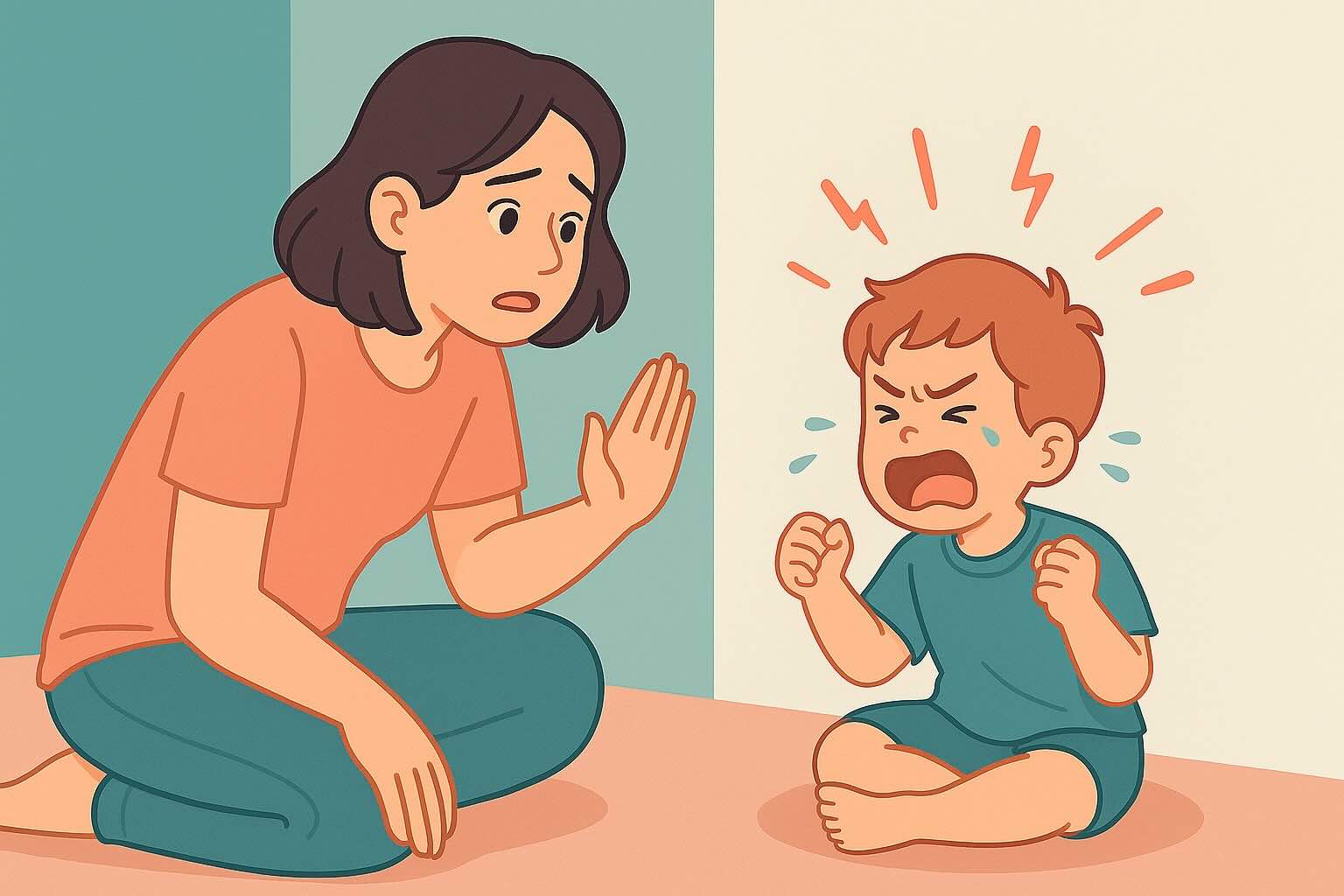Public Outburst Survival Guide: 7 Scripts That Help


Public Outburst Survival Guide: How to Handle Meltdowns in Stores, Restaurants & Social Settings
Proven strategies to maintain your calm and your child's dignity during public emotional episodes
You're in the cereal aisle when your 4-year-old spots their favorite cartoon character on a sugary cereal box. You say no. Suddenly, you're in the middle of a full-blown meltdown with what feels like the entire store watching. Your face burns with embarrassment as you calculate how quickly you can abandon your cart and escape.
Stop right there.
What you do in this moment will either teach your child that public spaces are where emotions control decisions, or that emotional regulation applies everywhere—a life skill worth its weight in gold.
This comprehensive guide provides you with the exact strategies, scripts, and mindset shifts you need to handle public outbursts with confidence while maintaining both your dignity and your child's. For age-specific strategies, see our guides on toddler tantrums and preschool outbursts.
What You'll Learn in This Guide
- The Public Outburst Mindset Shift - Why staying calm serves your child better than rushing to quiet them
- Prevention Strategies That Actually Work - How to prepare your child for challenging public situations
- Location-Specific Scripts - Exact words to use in grocery stores, restaurants, parks, and social gatherings
- The Art of Graceful Exit - When and how to leave situations while maintaining teaching opportunities
- Handling Spectators - What to do about stares, comments, and well-meaning advice
- Age Expectations - What's normal at 3 vs. 7 for public behavior
- Recovery and Follow-Up - How to process public outbursts afterward
Estimated reading time: 8 minutes
The Public Outburst Mindset Shift: Your Internal Game-Changer
Reframe the Situation: Teaching Moment vs. Embarrassing Failure
The old mindset: "Everyone is judging me. I need to stop this immediately. My child is being bad."
The new mindset: "This is a valuable learning opportunity. My calm, consistent response is teaching my child essential life skills. Most people understand."
The 5-Hour, 5-Day, 5-Month Test
When your child has a public outburst, pause and ask yourself:
"What will matter more in 5 hours, 5 days, 5 months?"
- That you were 20 minutes late leaving Target?
- Or that you effectively taught your child emotional regulation skills in a real-world setting?
"What will I remember in 5 months?"
- The embarrassment of temporary stares?
- Or the pride in handling a challenging moment with grace and consistency?
This mental framework helps you prioritize long-term child development over short-term social comfort.
Why Confident Parenting Impresses More Than Quick Fixes
Strangers respect calm, consistent parenting far more than frantically trying to quiet your child through bribes or threats. Most adults have been where you are and understand that children learning emotional regulation is normal development.
Your modeling matters: Other parents are often watching and learning from how you handle difficult moments. Your confidence gives them permission to parent authentically too.
Prevention: Setting Your Child Up for Public Success
The Pre-Departure Preparation Conversation
Prevention is key to managing public outbursts. For more prevention strategies, see our guide on tantrum prevention strategies.
For grocery stores: "We're going to the store. There will be toys and candy there. We're not buying toys or candy today. You might really want something. What can you do if you want something we're not buying?"
For restaurants: "We're going to a restaurant. You'll sit in your chair and use inside voices. Sometimes restaurants take a while to bring food. What can you do if you feel bored or hungry while we wait?"
For social gatherings: "We're going to Sarah's birthday party. She'll open presents and you might feel a little jealous. What can you do if you want to play with her new toys?"
Setting Clear, Specific Expectations
Instead of vague instructions like "be good":
Be specific:
- "Walking feet in the store"
- "Hands on the cart, not on products"
- "Inside voices only"
- "We're buying items on our list only"
The Choice Strategy (Not Bribes)
Appropriate choices that give control without teaching manipulation:
- "Would you like to carry the shopping basket or push the small cart?"
- "Do you want to help me find the apples or the bananas first?"
- "Would you like to sit on this side of the table or that side?"
Avoid bribes that teach emotions control decisions:
- "If you're good at the store, we'll get ice cream after"
- "Stop crying and I'll buy you that toy"
Location-Specific Strategies and Scripts
Grocery Store Outbursts: The Ultimate Testing Ground
Scenario 1: The Candy Aisle Meltdown
Child sees candy, asks for it, you say no, child begins crying and throwing themselves on the floor.
Your response:
- Stay calm and validate: "You really want that candy. I can see how much you want it."
- Maintain the boundary: "We're not buying candy today. You can feel disappointed about that."
- Redirect energy: "You can help me find the bread we need, or you can feel upset while we keep shopping."
- Follow through: Continue shopping while staying emotionally connected to your child.
What you might say while walking: "I hear you're still upset about the candy. You can tell me all about how disappointed you feel. That's okay. We're still not buying candy today."
Scenario 2: The Checkout Line Tantrum
Child sees all the impulse items at checkout and begins demanding multiple things.
Your response: "I see lots of things here that look interesting. We're buying the items in our cart today. You can look at these things with your eyes."
If escalation occurs: "You're feeling frustrated because you want things and I'm saying no. It's hard when we can't have everything we want. You can feel frustrated while we pay for our groceries."
Restaurant Outbursts: Managing the Wait and Social Pressure
Scenario 1: The Impatient Hunger Meltdown
Food is taking longer than expected, child becomes increasingly agitated.
Preparation strategy: Always bring small snacks for genuine hunger.
Your response to impatience outburst:
- Validate the feeling: "Waiting is hard. You're hungry and the food isn't here yet."
- Engage senses: "What sounds do you hear in this restaurant? What do you see?"
- Offer coping strategies: "You can rest your head on the table quietly, or we can count how many lights we see."
Scenario 2: The Social Overstimulation Meltdown
Child becomes overwhelmed by noise, people, or social expectations.
Your response:
- Acknowledge the overwhelm: "This place is loud and busy. Your body is telling you it's too much."
- Offer regulation help: "Let's do some quiet breathing together. In through your nose, out through your mouth."
- Create space: "We can sit here quietly for a few minutes while your body calms down."
Park and Playground Challenges
Scenario 1: The Transition Tantrum
Time to leave the park, child refuses and begins escalating.
Prevention: "We have 5 more minutes at the park. When the timer goes off, it's time to leave."
During the outburst:
- Validate the feeling: "You don't want to leave. Playing here is really fun."
- Maintain the boundary: "AND our time here is finished. You can feel sad about leaving."
- Offer choices within limits: "You can walk to the car yourself, or I can carry you. Either way, we're leaving now."
Social Gatherings and Family Events
Scenario 1: The Gift Envy Meltdown
At a birthday party, your child becomes upset about other children's gifts or attention.
Your response:
- Validate the feeling: "You wish it was your birthday too. You want presents and attention."
- Teach perspective: "Today is Emma's special day. Your birthday will come too."
- Redirect engagement: "What's one thing you can do to help Emma feel special on her birthday?"
If your child struggles with social situations due to sibling dynamics, see our guide on managing sibling outbursts.
When and How to Make a Graceful Exit
Situations That May Require Leaving
Consider leaving when:
- Your child's behavior is significantly disrupting others (loud, sustained screaming in quiet spaces)
- You feel too triggered to maintain calm, consistent responses
- Safety becomes a concern (running away, aggressive behavior toward others)
Stay when:
- You can maintain your emotional regulation
- The disruption is manageable and temporary
- Leaving would reinforce that outbursts control situations
The Graceful Exit Strategy
If you need to leave:
-
Stay calm and matter-of-fact: "We need to leave now because of the choices you're making."
-
Don't make it punitive: Avoid "That's it! We're leaving because you're being bad!"
-
Maintain dignity: "We'll try again another time when you're ready to use your inside voice."
-
Follow through with reflection: Later, discuss what happened and what will be different next time.
The Strategic Pause vs. Full Exit
Strategic pause (move to a quieter area temporarily):
- Take your child to a less crowded area
- Use sensory grounding techniques
- Allow a few minutes for regulation
- Return to the activity when appropriate
Full exit (leave the location entirely):
- When your child cannot regulate in the environment
- When you're too triggered to respond effectively
- When safety or significant disruption to others is occurring
Handling Spectators: Stares, Comments, and Advice
The Reality of Public Attention
Remember: Most people are more understanding than you think. Many parents have been exactly where you are and feel empathy, not judgment.
The few who judge: Their opinions reflect their own discomfort with emotions or lack of understanding about child development—not your parenting quality.
Responses to Common Comments
"Can't you control your child?" Your response: "We're working on emotional regulation skills." (Then refocus on your child.)
"When I was young, children didn't act like this." Your response: "Different approaches work for different families." (Smile and redirect attention.)
"You should try [unsolicited advice]." Your response: "Thanks for the suggestion." (No need to explain or defend your methods.)
Supportive comments from other parents: Your response: "Thank you for understanding. We're all learning together."
Body Language That Projects Confidence
- Relaxed posture: Avoid hunched, defensive positioning
- Calm facial expression: Your face should reflect patience, not panic
- Steady voice: Speak to your child in your normal tone, not whispered urgency
- Natural movements: Continue necessary activities rather than freezing in place
Age-Appropriate Expectations for Public Behavior
Understanding age-appropriate behavior is crucial. For detailed age comparisons, see our guide on 18-month vs 2-year tantrums and how development affects behavior.
Ages 3-4: Still Learning Social Awareness
What's normal:
- Occasional outbursts in any setting
- Limited understanding of "public vs. private" behavior
- Need for frequent reminders about expectations
- Difficulty with extended periods of "good behavior"
Realistic expectations:
- Brief errands with preparation usually manageable
- Longer outings may require breaks or shortened visits
- Outbursts will happen—focus on your response, not prevention
Ages 5-7: Developing Social Understanding
What's normal:
- Crying or expressing disappointment in public settings
- Occasional loss of emotional control during stress or fatigue
- Generally understanding that different settings have different rules
Concerning patterns:
- Regular explosive outbursts in public after age 6
- Inability to recover from disappointments in social settings
- Aggressive behavior toward others in public consistently
Realistic expectations:
- Most public outings should be manageable with preparation
- Major outbursts should become increasingly rare
- Child should begin showing awareness of social context
Recovery and Follow-Up: Processing Public Outbursts
The Immediate Aftermath
In the car or at home, once emotions have settled:
Acknowledge what happened without shame: "That was hard for both of us. You got really upset at the store when I said no to the toy."
Avoid blame or guilt: Don't say: "You embarrassed me" or "Everyone was looking at us." Instead: "You felt disappointed, and disappointing feelings are really big sometimes."
The Reflection Conversation (Later)
Wait for a completely calm moment (that evening or the next day):
Tell the story together: "Remember yesterday at the store? You really wanted that toy, and when I said no, you started crying and throwing yourself on the floor. What do you remember about that?"
Problem-solve for next time: "Next time you really want something at the store, what could you do instead? What words could you use to tell me how you feel?"
Practice the skills: "Let's practice. Pretend I'm saying no to something you want. Show me what you could do instead of throwing yourself down."
Building Confidence for Future Outings
Start with easier public situations after a difficult experience:
- Quick errands rather than lengthy shopping trips
- Familiar places rather than new environments
- Times when your child is well-rested and fed
Celebrate improvements: "Remember last week when you got upset about not getting candy? Today when I said no to the toy, you used your words to tell me you felt disappointed. That's exactly what we've been practicing!"
Success Stories: Real Families in Real Public Situations
The Coffee Shop Learning Moment
"My 4-year-old had a complete meltdown in a busy coffee shop because they ran out of his favorite muffin. Instead of rushing out, I sat with him and validated his disappointment while he cried. Several other parents came over to offer support and share similar stories. I realized that handling it calmly actually connected me with other understanding parents rather than isolating me."
The Restaurant Recovery
"We used to avoid restaurants entirely because of my daughter's outbursts. Learning to prepare her beforehand and stay calm during episodes changed everything. Last month, she started getting upset about the wait time, but I used sensory grounding ('What colors do you see?' 'What sounds do you hear?') and she actually helped me count things around the restaurant. The server even complimented how well she handled her big feelings."
Your Public Outburst Toolkit: Quick Reference
Before Leaving Home
- Child is fed and rested
- Expectations clearly communicated
- Backup plan discussed
- Small snacks packed if needed
During Public Outbursts
- Take a deep breath and regulate yourself first
- Validate their emotions: "You're feeling..."
- Maintain boundaries: "AND we still..."
- Use sensory grounding if helpful
- Continue necessary activities when possible
After Public Outbursts
- Avoid shame or blame in immediate aftermath
- Schedule reflection conversation for later
- Practice alternative strategies together
- Plan for future success
Key Takeaways: Your Public Outburst Survival Guide
- ✅ Your calm response teaches more than quick fixes - Consistency matters more than immediate quiet
- ✅ Preparation prevents many public outbursts - Clear expectations and choices within limits work
- ✅ Most people are more understanding than judgmental - Focus on your child, not spectators
- ✅ Age-appropriate expectations prevent frustration - 3-year-olds and 6-year-olds have different capabilities
- ✅ Strategic exits are sometimes necessary - Leaving can be part of teaching, not giving up
- ✅ Reflection conversations build future success - Processing experiences prevents repetition
- ✅ Public outbursts become learning opportunities - Real-world practice builds genuine skills
- ✅ Your confidence grows with experience - Each handled outburst makes the next one easier
Remember: Every public outburst you handle with calm consistency is teaching your child that emotional regulation applies everywhere—a gift that will serve them for life.
This guide is based on child development research and real-world parenting experience. Individual situations vary, and building these skills takes time and practice. Trust yourself and stay consistent with your approach.
Challenging Moments Support
Access step-by-step parenting strategies, quick tips, and age-specific guidance for difficult situations when you need it most.

Struggling with tantrums?
Get personalized coaching support available 24/7. Your parenting coach understands what you're going through.
Try RootWise Free →Free Tantrum Scripts
Help your toddler manage big emotions with these strategies and scripts.
Frequently Asked Questions
Need personalized support?
RootWise's AI coach can provide tailored strategies for your specific situation, available 24/7 when you need it most.
Learn More About AI Coaching →



